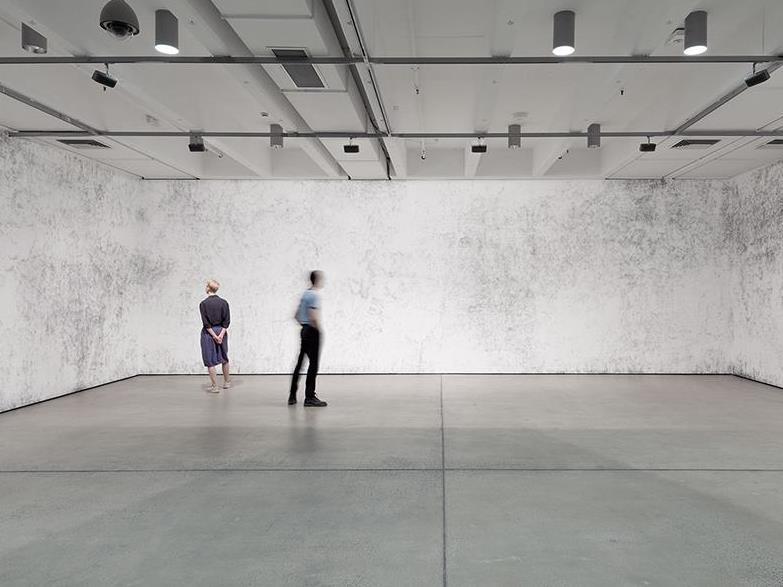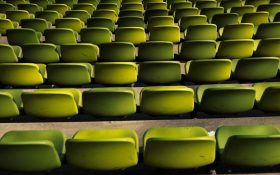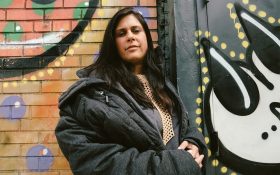Image Tom Nicholson, Cartoons for Joseph Selleny, 2014, Wall drawing created through pouncing with cheesecloth full of ground charcoal, Dimensions variable, Courtesy of the artist and Milani Gallery, Brisbane. Realised with Chelsea Charlton, Anya Swan, Kinly Grey, Charlie Hillhouse, Sarah Poulgrain, with preparation of cartoons by Olivia Koh. Photograph: Christian Capurro via IMA Brisbane.
An important show that draws upon little known yet epic encounters, intersections and histories that have surprising resonances for Australians. Tom Nicholson’s drawings and correspondence in text bring these stories to our awareness but they are also dialogues about picture making.
This solo exhibition has been curated by Aileen Burns and Johan Lundh from Brisbane’s Institute of Modern Art. Nicholson’s work is also currently part of the 21st Sydney Biennale and has been shown previously in contemporary art events in Jakarta (16th Jakarta Biennale, Sydney (AGNSW and MCA) and Melbourne (Ian Potter Museum). He is represented by the Milani Gallery, Brisbane.

Image Tom Nicholson, Drawings and correspondence. Installation view: IMA Brisbane, 2018. Photograph: Christian Capurro. In view: Drawings and Correspondence 9, 2008-2011, Drawings and Correspondence 1, 2008-2011, and Cartoons for Joseph Selleny (detail), 2014, wall drawing via IMA Brisbane.
This show at IMA is a series of collections developed between 2005 and 2018 of works on paper with artist’s books, posters and foldout sheets to take away, as well as a subtle text work on the wall itself. The artist books include reproductions of relevant images and text – correspondence between the artist, his colleagues and perhaps imagined actors in some of these stories.
The works are extensively researched and source archival visual and written materials. With this thoroughness, Nicholson has created space for conjecture.
Drawing may be the common ‘thread’ but the black works are dense layered surfaces of compressed and willow charcoal. The line is reserved for the subtle text on the walls, negative marks, drypoint etchings and booklets.
Taken together, drawing becomes an act for defining and opening up in which ‘line is a tool for writing, drawing and redrawing borders … and expanding into the space of possibility through abstraction.’
For this viewer, the abstraction of the hazy soft black voids, black points and gestural lines allows for the ambiguity and emotion to step in.
Borders are the focus of the Untitled wall drawing (2005-2018). This researched piece reveals the political flux of nations since 1901. Australia act of federation in 1901 of course was superimposed on multiple indigenous nations.
This work is huge, subtle and invites further investigation. The contrast with the velvety black charcoal images close by tests the commitment of the viewer to undertake this close scrutiny.
The Gorge Photographs (2018) are the eight charcoal drawings with an accompanying foldout. Together they reference the work of photographic work Rex Batterbee and Albert Namatjira at the outbreak of World War II. The work provokes an enquiry into the practice, relationships, achievements and potential of these two artists at a time when Namatjira was becoming broadly known and in the decades before the Papunya works.
Drawings and Correspondence (2008-2011) is another complex piece in this instance, dealing with settler and Aboriginal engagement in Melbourne/Naarm, display, myth making, picture making and contested truths.

Image Tom Nicholson, Cartoons for Joseph Selleny, 2014, 12 cartoons (charcoal drawings perforated). Photograph: Christian Capurro via IMA Brisbane.
Cartoons for Joseph Selleny (2014) inhabits a large central area of the gallery on a major scale. Where to look: the layered, hazy ‘pounced’ charcoal drawings (cartoons) used to trace Nicholson’s drawings of Manet’s Execution of Maximilian in charcoal powder onto three high walls? the ‘pounced’ traces of charcoal on those walls recording the merest suggestions of figures and the historical event itself?
The paper cartoons themselves seem to be disappearing into darkness, but their ‘pouncing’ holes continue to define them. The ‘pounced’ walls, in contrast, have become almost a negative night sky that seems to float.
The subject matter, the intersections of historical events – real and conjectured – and surprising personal connections attached to this work are a compelling read.

Image Tom Nicholson, Drawings and correspondence. Installation view: IMA Brisbane, 2018. Photograph: Christian Capurro via IMA Brisbane.
Beyond the cartoons, the visitor must not miss the printed broadsheet, poster image and the series of drypoint etchings – Lines that Could Be Scars (2015). These works reference a drawing by the late 18th century artist John Webber who accompanied Cook on the voyage. Webber’s sketch ‘records’ Captain Cook ‘interviewing’ the Indigenous people at Two Tree Point on Bruny Island in Tasmania at their first encounter.
The printed conversations and foldout images available with the hung works are inherent to the visitor’s deeper engagement. Taken together, they explore issues of documentation, picture making, history painting – and of course deep questions of history itself.
In addition, the exhibition is accompanied by the first monograph of Nicholson’s work, Lines towards Another, edited by Amelia Barikin and Helen Hughes, and co-published by the IMA, the Australian Centre for Contemporary Art, and Sternberg Press. So much to explore.
I came to this show with new eyes and became engrossed by these black revelations and accessible text. As I looked and read, I wanted to revisit the show but I also found myself making my own personal intersections with the material. For visitors who engage with all the material, there are rewards of valuable insight.
Rating: ★★★★☆





